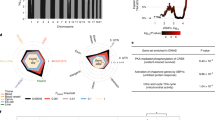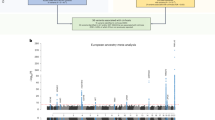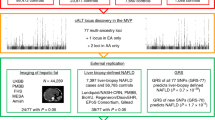Abstract
Lumiracoxib is a selective cyclooxygenase-2 inhibitor developed for the symptomatic treatment of osteoarthritis and acute pain1. Concerns over hepatotoxicity have contributed to the withdrawal or non-approval of lumiracoxib in most major drug markets worldwide. We performed a case-control genome-wide association study on 41 lumiracoxib-treated patients with liver injury (cases) and 176 matched lumiracoxib-treated patients without liver injury (controls). Several SNPs from the MHC class II region showed strong evidence of association (the top SNP was rs9270986 with P = 2.8 × 10−10). These findings were replicated in an independent set of 98 lumiracoxib-treated cases and 405 matched lumiracoxib-treated controls (top SNP rs3129900, P = 4.4 × 10−12). Fine mapping identified a strong association to a common HLA haplotype (HLA-DRB1*1501-HLA-DQB1*0602-HLA-DRB5*0101-HLA-DQA1*0102, most significant allele P = 6.8 × 10−25, allelic odds ratio = 5.0, 95% CI 3.6–7.0). These results offer the potential to improve the safety profile of lumiracoxib by identifying individuals at elevated risk for liver injury and excluding them from lumiracoxib treatment.
This is a preview of subscription content, access via your institution
Access options
Subscribe to this journal
Receive 12 print issues and online access
$209.00 per year
only $17.42 per issue
Buy this article
- Purchase on Springer Link
- Instant access to full article PDF
Prices may be subject to local taxes which are calculated during checkout


Similar content being viewed by others
References
Bannwarth, B. & Berenbaum, F. Lumiracoxib in the management of osteoarthritis and acute pain. Expert Opin. Pharmacother. 8, 1551–1564 (2007).
Senior, J.R. Drug hepatotoxicity from a regulatory perspective. Clin. Liver Dis. 11, 507–524 (2007).
Kaplowitz, N. Idiosyncratic drug hepatotoxicity. Nat. Rev. Drug Discov. 4, 489–499 (2005).
Navarro, V.J. & Senior, J.R. Drug-related hepatotoxicity. N. Engl. J. Med. 354, 731–739 (2006).
US Department of Health and Human Services, Public Health Service. Food and Drug Administration Guidance for Industry Drug-Induced Liver Injury: Premarketing Clinical Evaluation. 〈http://www.fda.gov/downloads/Drugs/GuidanceComplianceRegulatoryInformation/Guidances/UCM174090.pdf〉 (July 2009).
Farkouh, M.E. et al. Comparison of lumiracoxib with naproxen and ibuprofen in the Therapeutic Arthritis Research and Gastrointestinal Event Trial (TARGET), cardiovascular outcomes: randomised controlled trial. Lancet 364, 675–684 (2004).
Matchaba, P. et al. Cardiovascular safety of lumiracoxib: a meta-analysis of all randomized controlled trials > or =1 week and up to 1 year in duration of patients with osteoarthritis and rheumatoid arthritis. Clin. Ther. 27, 1196–1214 (2005).
Schnitzer, T.J. et al. Comparison of lumiracoxib with naproxen and ibuprofen in the Therapeutic Arthritis Research and Gastrointestinal Event Trial (TARGET), reduction in ulcer complications: randomised controlled trial. Lancet 364, 665–674 (2004).
Oksenberg, J.R., Baranzini, S.E., Sawcer, S. & Hauser, S.L. The genetics of multiple sclerosis: SNPs to pathways to pathogenesis. Nat. Rev. Genet. 9, 516–526 (2008).
Temple, R. Hy's law: predicting serious hepatotoxicity. Pharmacoepidemiol. Drug Saf. 15, 241–243 (2006).
Uetrecht, J. Idiosyncratic drug reactions: current understanding. Annu. Rev. Pharmacol. Toxicol. 47, 513–539 (2007).
Pichler, W.J. et al. Pharmacological interaction of drugs with immune receptors: the p-i concept. Allergol. Int. 55, 17–25 (2006).
Mallal, S. et al. HLA-B*5701 screening for hypersensitivity to abacavir. N. Engl. J. Med. 358, 568–579 (2008).
Mallal, S. et al. Association between presence of HLA-B*5701, HLA-DR7, and HLA-DQ3 and hypersensitivity to HIV-1 reverse-transcriptase inhibitor abacavir. Lancet 359, 727–732 (2002).
Hetherington, S. et al. Genetic variations in HLA-B region and hypersensitivity reactions to abacavir. Lancet 359, 1121–1122 (2002).
Daly, A.K. et al. HLA-B*5701 genotype is a major determinant of drug-induced liver injury due to flucloxacillin. Nat. Genet. 41, 816–819 (2009).
Chung, W.H. et al. Medical genetics: a marker for Stevens-Johnson syndrome. Nature 428, 486 (2004).
Kindmark, A. et al. Genome-wide pharmacogenetic investigation of a hepatic adverse event without clinical signs of immunopathology suggests an underlying immune pathogenesis. Pharmacogenomics J. 8, 186–195 (2008).
Hautekeete, M.L. et al. HLA association of amoxicillin-clavulanate–induced hepatitis. Gastroenterology 117, 1181–1186 (1999).
O'Donohue, J. et al. Co-amoxiclav jaundice: clinical and histological features and HLA class II association. Gut 47, 717–720 (2000).
Purcell, S. et al. PLINK: a tool set for whole-genome association and population-based linkage analyses. Am. J. Hum. Genet. 81, 559–575 (2007).
Acknowledgements
The authors thank C. Hurwitz, J. Decker, G. Yarbrough, J. Somers, C. Wache-Mainier, M. Waldvogel and N. Hartmann for the help in genotyping the samples; S. Stavar for assistance with data management and Y. He and R. Yelensky for helpful discussions; P. Vancutsem for input into the project; and all the patients who participated in the TARGET study and all the investigators of the TARGET study group.
Author information
Authors and Affiliations
Contributions
The genome-wide association study was designed by C.A.P., S.L., J.M. and J.B.S. with analysis and interpretation performed by C.A.P., S.L., J.B.S., J.M. and F.Y. The HLA fine mapping study was designed by C.A.P., J.B.S. and S.L., and analysis and interpretation was performed by C.A.P., J.B.S., S.L., J.M., L.K. and T.M.W. Genotyping was supervised and performed by E.L. and X.Z. C.A.P., S.L. and J.B.S. wrote the first draft of the manuscript, and all other authors contributed to and approved the final draft.
Corresponding author
Ethics declarations
Competing interests
All authors are employees and stockholders of Novartis.
Supplementary information
Supplementary Text and Figures
Supplementary Tables 1–6, Supplementary Figures 1–5 and Supplementary Note (PDF 493 kb)
Rights and permissions
About this article
Cite this article
Singer, J., Lewitzky, S., Leroy, E. et al. A genome-wide study identifies HLA alleles associated with lumiracoxib-related liver injury. Nat Genet 42, 711–714 (2010). https://doi.org/10.1038/ng.632
Received:
Accepted:
Published:
Issue Date:
DOI: https://doi.org/10.1038/ng.632
This article is cited by
-
Genome-wide association study of abnormal elevation of ALT in patients exposed to atabecestat
BMC Genomics (2023)
-
Managing the challenge of drug-induced liver injury: a roadmap for the development and deployment of preclinical predictive models
Nature Reviews Drug Discovery (2020)
-
Drug-Induced Liver Injury Due to Nonsteroidal Anti-inflammatory Drugs
Current Hepatology Reports (2019)



